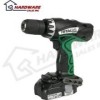Hitachi DV18DCL Handling Instructions - Page 9
Change rotation speed - dv18dcl2 battery
 |
UPC - 717709013025
View all Hitachi DV18DCL manuals
Add to My Manuals
Save this manual to your list of manuals |
Page 9 highlights
(2) Tightening torque indication The tightening torque differs depending on the type of screw and the material being tightened. The unit indicates the tightening torque with the numbers "1, 3, 5 ... 22" on the clutch dial, and a dots. The tightening toque at position "1" is the weakest and the torque is strongest at the highest number (See Fig. 4). (3) Adjusting the tightening torque Rotate the clutch dial and line up the numbers "1, 3, 5 ... 22" on the clutch dial, or the dots, with the triangle mark on the outer body. Adjust the clutch dial in the weak or the strong torque direction according to the torque you need. CAUTION ○ The motor rotation may be locked to cease while the unit is used as drill. While operating the drill, take care not to lock the motor. ○ Too long hammering may cause the screw broken due to excessive tightening. 3. Rotation to hammer changeover (See Fig. 4) The "Rotation (Rotation only)" and "hammer (hammer + Rotation)" can be switched by aligning the drill mark " " or the hammer mark " " with the triangle mark on the outer body. ○ To make holes in the metal, wood or plastic, switch to "Rotation (Rotation only)". ○ To make holes in bricks or concrete blocks, switch to "hammer (Impact + Rotation)". CAUTION ○ If an operation which is normally performed at the "Rotation" setting is performed at "hammer" setting, the effect of making holes does not only increase but it may also damage the bit or other parts. ○ If it is hard to turn the clutch dial to hammer mark " " position, turn the chuck slightly in either direction and then turn the clutch dial to hammer mark " " position again. 4. Change rotation speed Operate the shift knob to change the rotational speed. Move the shift knob in the direction of the arrow (See Figs. 6 and 7). When the shift knob is set to "LOW", the drill rotates at a low speed. When set to "HIGH", the drill rotates at a high speed. CAUTION ○ When changing the rotational speed with the shift knob, confirm that the switch is off. Changing the speed while the motor is rotating will damage the gears. ○ When setting the shift knob to "HIGH" (high speed) and the position of the clutch dial is between "15" and "22", it may happen that the clutch does not engaged and that the motor is locked. In such a case, please set the shift knob to "LOW" (low speed). ○ If the motor is locked, immediately turn the power off. If the motor is locked for a while, the motor or battery may be burnt. ○ To extend the lifetime, the lithium-ion battery equips with the protection function to stop the output.Therefore, if the tool is overloaded, the motor may stop. However, this is not the trouble but the result of protection function. In this case, release the switch of tool and eliminate the causes of overloading. 5. The scope and suggestions for uses The usable scope for various types of work based on the mechanical structure of this unit is shown in Table 4. Drilling Driving Work Brick Wood Steel Aluminum Machine screw Wood screw Table 4 Suggestions Use for drilling purpose. Use the bit or socket matching the screw diameter. Use after drilling a pilot hole. 6. How to select tightening torque and rotational speed Table 5 Use Clutch Dial Position Rotating speed selection (Position of the shift knob) LOW (Low speed) HIGH (High speed) Driving Machine screw Wood screw 1 - 22 1 - For 4 mm or smaller diameter screws. For 8 mm or smaller nominal diameter screws. For 6 mm or smaller diameter screws. For 4.8 mm or smaller nominal diameter screws. Brick For 13 mm or smaller diameters. For 8 mm or smaller diameters. (DV14DCL2) For 10 mm or smaller diameters. (DV18DCL2) Drilling Wood For 32 mm or smaller diameters. (DV14DCL2) For 38 mm or smaller diameters. (DV18DCL2) For 18 mm or smaller diameters. (DV14DCL2) For 22 mm or smaller diameters. (DV18DCL2) Metal For drilling with a metal working drill bit. 9















